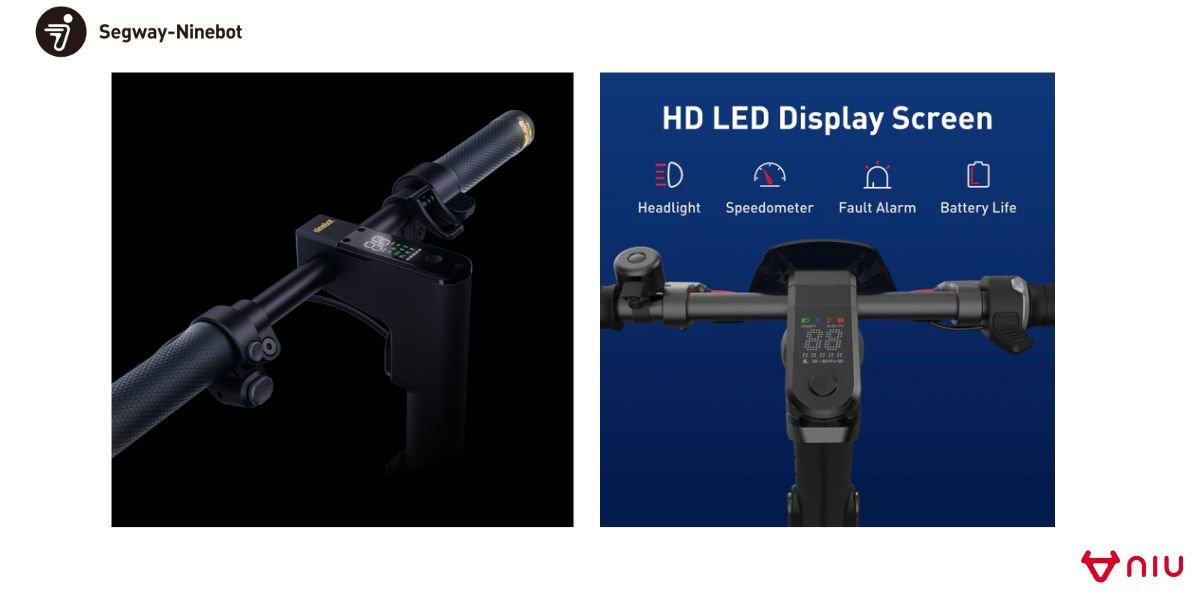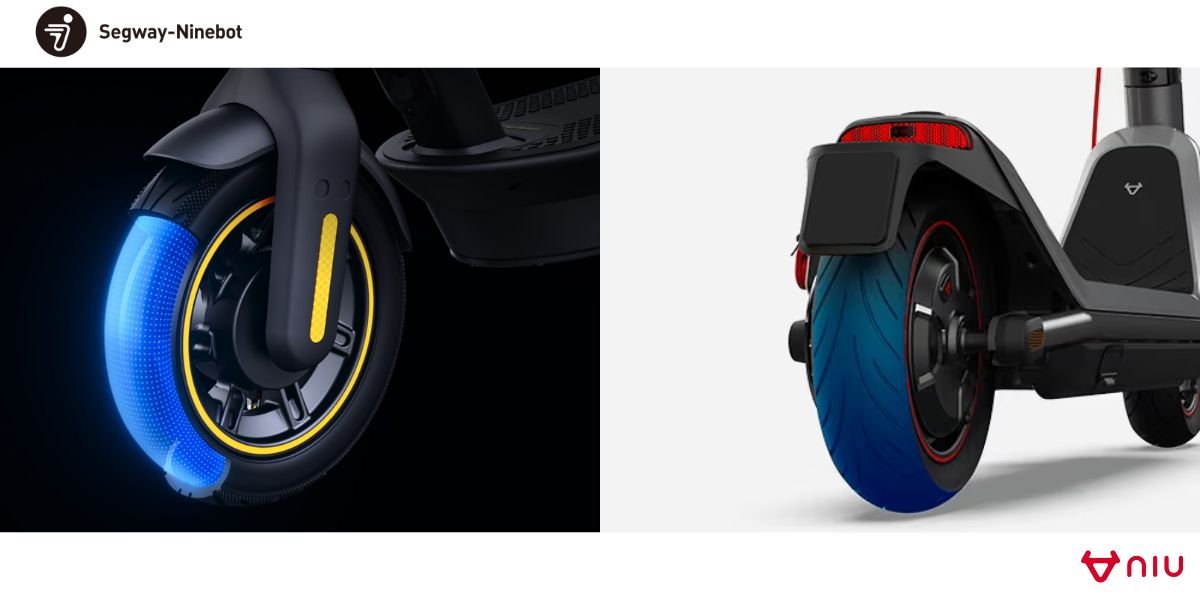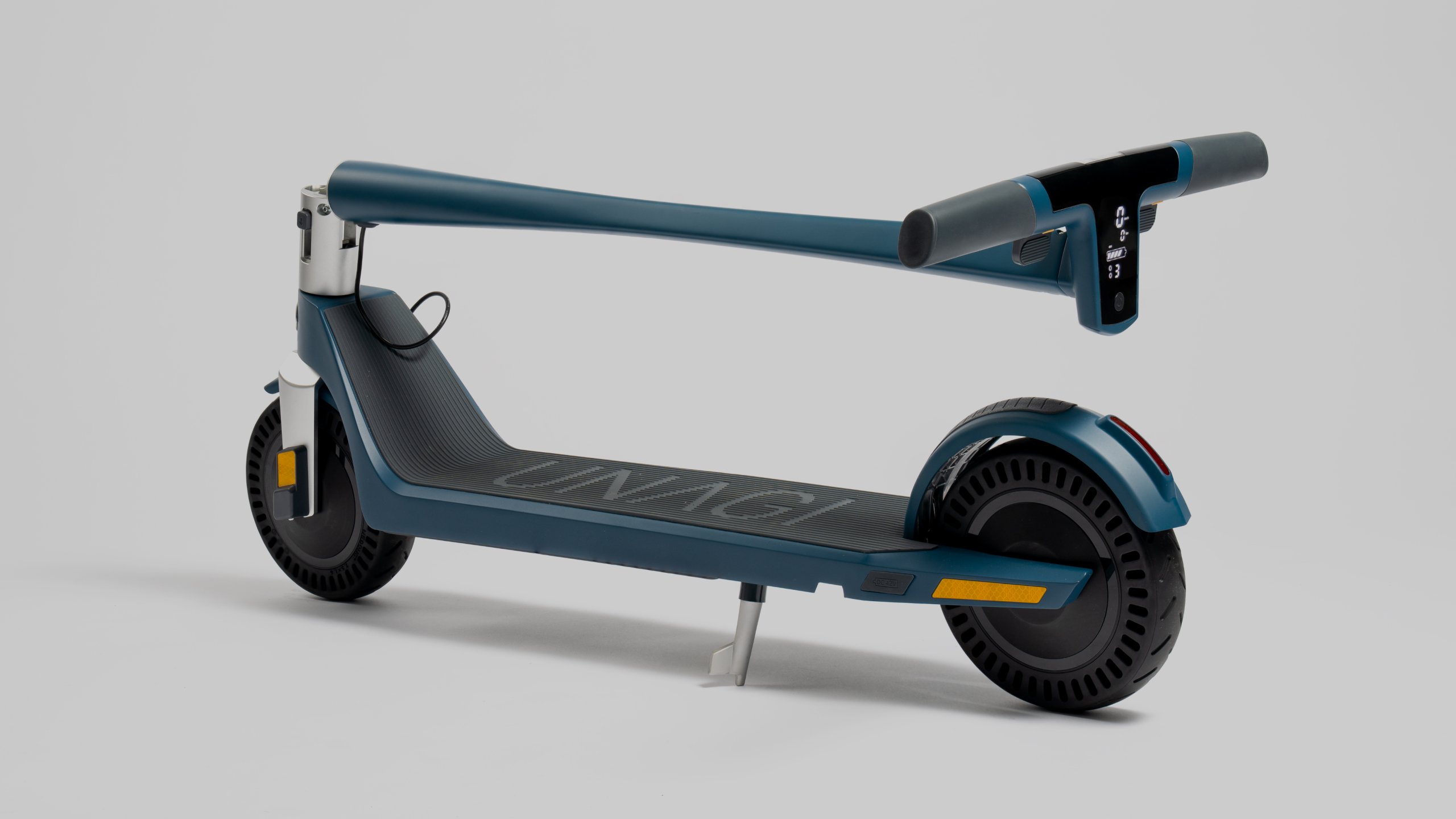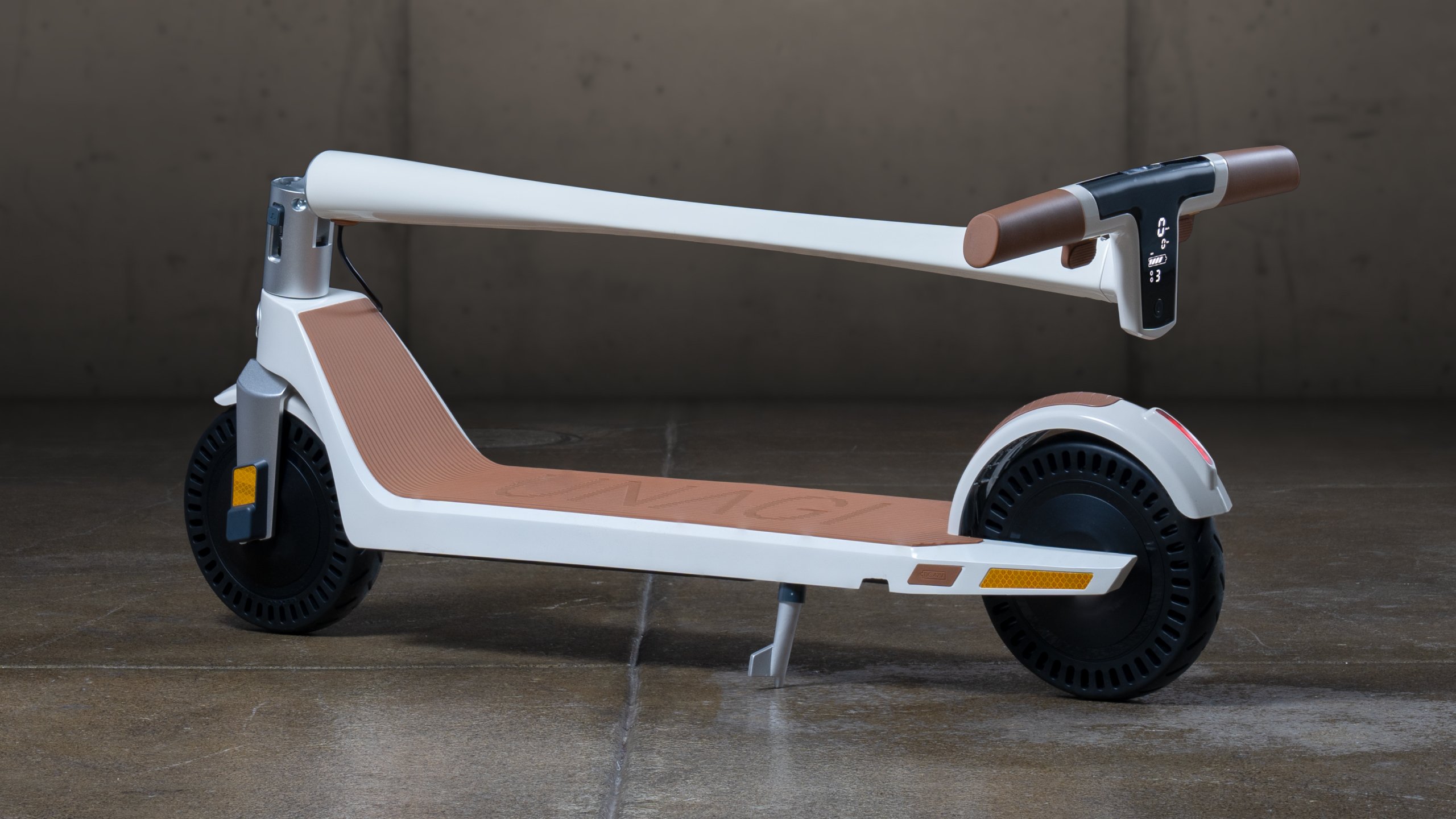Micromobility is here to stay, and it’s changing how we experience urban life for the better. With Unagi’s membership program, you can enjoy all the benefits of a top-tier electric scooter without the sky-high price of ownership or the inconvenience of ride-sharing.
This article compares two of the best electric scooters in their class, the Segway Ninebot Max G2 and the NIU KQi3 Max, to find out which one is the best for your commuting needs.
The Segway Ninebot Max has been the industry benchmark for performance and reliability for a while now. The scooter has one of the best range-per-dollar, good top speed, a comfortable ride, and proven durability. The Segway Max Ninebot G2 is all that, with major upgrades including suspension.
The NIU KQi3 MAx was definitely designed to compete with the Segway Ninebot Kickscooter Max electric scooter. It is the maxed-out version of their high-performance KQi3 Pro and one that heavier adult riders will love. And with NIU’s experience in manufacturing electric vehicles, quality and durability are guaranteed.
So, let's dive deep into what sets these electric scooters apart and help you determine which one best suits your needs.
Cost
The Segway Ninebot Max G2 is priced at $999, positioning itself as a premium commuter option. The price reflects significant upgrades from its predecessor, the Ninebot Max G30, including improved range, enhanced reliability, and forward-looking features like traction control.
The NIU KQi3 Max, priced at $799, is slightly more affordable than the Ninebot Max G2 but offers comparable premium features. Both scooters represent significant investments, but their build quality, performance, and feature sets justify the price point.
Performance
The performance of these electric scooters is what sets them apart in their price class. They are both great for beginners, intermediate, and even experienced riders.

Motor and Power
The Segway Ninebot Max G2 features a rear 450W powerful motor with a peak output of 1000W. The KQi3 Max counters with a 450W motor (900W peak), creating an interesting matchup in terms of raw power.
However, it’s important to note that the KQi3 Max runs on a 48V system, meaning there’s no significant loss of power towards the end of the battery, compared to most electric scooters like the Ninebot Max G2 with 36V systems.
Speed and Acceleration
Both electric scooters deliver impressive acceleration and top speeds. The Ninebot Max G2 reaches 15 mph in 4.1 seconds and achieves a maximum speed of 22 mph. The KQi3 Max accelerates to 15 mph in 4.6 seconds and also tops out at 22 mph. Note that the NIU is a kick-start scooter, without the option for zero start.
The Ninebot Max G2 offers varied speed modes, starting with Eco mode at 10 mph, Drive mode at 16 mph, and Sport mode reaching 22 mph. Similarly, the KQi3 Max provides flexible riding options with E-Save mode at 9 mph, Drive mode at 16 mph, Sport mode at 22 mph, and a Custom mode allowing you to determine your preferred top speed.
Range and Battery
The Segway Ninebot Max G2 has a 551Wh battery that can power the e-scooter through a tested range of 27 miles in real-world performance. Segway advertises that in ideal conditions, this can go up to 43 miles. It also has a unique built-in charger, which eliminates the need to carry a separate charging brick.
The KQi3 Max, on the other hand, has a 608.4Wh battery, which facilitated a maximum range of 23.3 miles in a real-world range test. NIU claims this can go to 40.4 miles in ideal settings.
While the battery capacity is larger on the NIU, the range is slightly lower, and we can credit this to Segway’s RideyLong technology–an efficient power management system that leverages a high-performance brushless motor and low rolling resistance tires to deliver more miles and preserve battery life.
Hill Climbing
On a 200 ft, 10% grade hill test, the Ninebot Max G2 completed the climb in 13.7 seconds at an average speed of 9.9 mph. In the same tests, the KQi3 Max took 14.4 seconds at an average speed of 9.4 mph.
Braking
The Segway Max G2 utilizes a front drum brake and rear regenerative electronic brake, achieving a stopping distance of 12 feet from 15 mph. The braking is approachable and you’re guaranteed the brakes won’t lock up.
The KQi3 Max features a triple braking system with dual disc brakes and regenerative braking, stopping in 9.3 feet from 15 mph, making it the superior performer in this category. The electric scooter’s variable regen means the harder you pull on the brakes, the more regen you get–and the intensity can be set on the app.
Build Quality
It’s hard to say which is the better-built scooter. On one hand, NIU has an attention to detail that’s indicative of their experience in the e-mobility space and is backed by a 2-year warranty. While the Max G2 is meant to give riders an affordable experience of Segway’s flagship GT2, showing the same thought and intent in design--even integrating with Apple's Find My ecosystem.
Materials and Durability
Both manufacturers prioritize durability and quality construction. The Ninebot Max G2 uses an aero-grade aluminum alloy frame, reinforced ABS plastic components, and quality silicone covers for grips and various components.
The KQi3 Max electric scooter features an aerospace-grade aluminum frame, high-quality plastic components, and premium rubber grips and deck covering. The rubber deck is a different take from the grip-tape cover characteristic of models like the NIU KQi2 Pro.
Aesthetics
The Ninebot Max G2 comes in gunmetal gray with black and mustard accents, featuring clean lines and hidden cable routing through the stem. The KQi3 Max sports a distinctive space gray finish with red highlights, offering a modern, sophisticated look that stands out in the commuter category.
Ride Quality
The Segway Ninebot Max G2 delivers a smoother ride courtesy of some distinct design choices. However, both electric scooters are designed to carry a max rider weight of 265 lbs, making them perfect for heavier adults.
Tires
The Segway Max G2 electric scooter features 10-inch tubeless, self-healing pneumatic tires with excellent puncture resistance and integrated traction control for wet conditions. They also have low rolling resistance, which contributes to the scooter's long range.
The KQi3 Max comes with 9.5-inch tubeless pneumatic CST tires with self-healing technology, providing good grip and shock absorption. The ride feels a bit firm, unlike that of the NIU KQi2, which came with 10-inch pneumatic tires.

Suspension
The Segway Ninebot Max G2 includes a full suspension setup with a front hydraulic damper and spring rear adjustable dual suspension system. The shocks feel amazing and work with the air tires to elevate ride comfort. The KQi3 Max doesn't feature dedicated suspension and instead relies on its pneumatic tires for shock absorption.
Deck
The Ninebot Max G2 has a deck measuring 19.8 x 7.3 inches, while the KQi3 Max comes with a 20 x 6.5 inches riding platform. Both decks provide more than enough space for comfortable foot placement by the average adult rider and feature grippy rubber surfaces. The KQi3 Max has a structured footrest that comes in handy during hard stops–but you won’t get that on the Max G2 electric scooter.
Portability
The upgrades on the Ninebot Max G2 bring the new weight to 53.5 lbs with folded dimensions of 47.5 x 22.5 x 24 inches, making it one of the heavier options in its class. The KQi3 Max weighs 47 lbs and folds to 45.3 x 21.8 x 20.5 inches, offering slightly better portability. However, if you want the best lightweight electric scooter without compromising on performance, consider the 29.6 lbs Unagi Model One Voyager.
Water Resistance
The Ninebot Max G2 features an IPX5 rating with an IPX7 rating for the battery, while the KQi3 Max offers IP54 protection. While these water resistance ratings don’t make the scooters are waterproof, they do mean that you can ride for a while in light showers as you seek shelter without damaging the scooter's electronics. Both electric scooters also come with a strong front and rear fender to keep road spray off your feet.
App and Controls
Both electric scooters offer comprehensive smartphone apps with various features. The Segway app includes customizable acceleration and regenerative braking, battery charging limit settings, zero start option, cruise control management, traction control settings, and Apple Find My integration–a first on an electric scooter.
The KQi3 Max's app provides riding statistics tracking, battery health monitoring, custom speed settings, remote locking/unlocking, regenerative braking adjustment, and cruise control settings. Like NIU’s other scooters, you also have to complete a safety tutorial on the app, before you can unlock the scooter’s top speed.

Lighting
The Ninebot Max G2 electric scooter comes equipped with standard lighting: a bright headlight, tail light with brake light function, state-of-the-art, high-mounted, self-canceling turn signals, and multiple reflectors.
The KQi3 Max includes a high-mounted headlight, NIU’s signature halo daytime running light, a large rear light with brake light function, and side reflectors.
Both scooters are ideal for riders who frequently ride in low-light conditions. However, always wear reflective clothing to increase your visibility to vehicle drivers.
Ninebot Max G2 vs NIU KQi3 Max: Verdict
The choice between the Segway Ninebot Max G2 and NIU KQi3 Max electric scooters ultimately depends on your specific needs and preferences.
The Ninebot Max G2 excels with a superior range, a full suspension system, advanced traction control, Apple Find My integration, and a higher water resistance rating. The KQi3 Max stands out for superior braking performance, lighter weight, larger battery capacity, more competitive price point, and its two-year warranty.
For riders prioritizing range and ride comfort, the Ninebot Max G2's full suspension system and longer range make it the better choice. However, if superior braking, lighter weight, and value are your primary concerns, the KQi3 Max offers an excellent alternative with its robust feature set and longer warranty period.
Both scooters represent the premium end of the commuter category, offering reliable performance, quality construction, and advanced features that justify their price points. Your final choice should align with your specific commuting needs, storage situation, and riding preferences.
The Unagi Model One Voyager: A Compelling Alternative

Both the Segway Ninebot Max G2 and KQi3 Max offer excellent value in the premium commuter segment. However, the Unagi Model One Voyager presents an innovative alternative, especially for those considering the cost.
The Voyager introduces a revolutionary approach through its All-Access membership plan at $79 per month – a monthly payment plan that takes away significant upfront costs sustained during acquisition.
However, it’s not just the payment structure that makes it a great consideration. The electric scooter features dual 250W motors delivering a combined 1000W peak power output, matching the Ninebot Max G2's power while offering superior acceleration and hill-climbing ability.
The Voyager’s 360Wh battery capacity achieves a range of 12-25 miles. And while the scooter's range is less than both the Ninebot and NIU electric scooters, the Voyager compensates with a remarkably fast 3-hour charging time compared to the 6-9-hour charge times of its competitors. Plus, the energy-dense cells used contribute to battery longevity.

The Voyager also brings the fight in portability and construction. At just 29.6 lbs, it's significantly lighter than both the Segway Ninebot Kickscooter Max G2 (53.5 lbs) and KQi3 Max (47 lbs). The scooter's premium materials, including carbon fiber stem, magnesium alloy handlebars, and single-piece machined aluminum frame, contribute to both its lightweight nature and exceptional durability.
The All-Access membership plan eliminates common ownership concerns by including:
- Free maintenance and repairs
- Theft protection insurance
- Express delivery within 2-3 days
- Easy upgrades to newer models
- Free cancellation without penalty
The Voyager’s innovative subscription model, combined with premium build quality, solid performance metrics, and reliable ride makes it a worthy alternative to traditional ownership models, particularly for riders prioritizing portability and peace of mind.

Stay current with the latest U.S. electric scooter laws in our 2025 guide. Updated annually since our first comprehensive guide, ensuring you have the most recent state and city regulations to ride responsibly”

The Slack Core 920R is currently the fastest electric scooter in 2025 that you can purchase without the need for pre-order.

Our selection of the best electric scooters 2025 spans the fastest e-scooters to the most portable ones, the ones designed for city riding and off-road, the best scooters for rain, budget electric scooters for students, and more powerful ones for skilled riders.

The Unagi Voyager is the best lightweight electric scooter for adults and teenagers. It is the ultraportable sequel to its predecessor, the Unagi Model One Classic.

If you're wondering whether an electric scooter with a seat is right for you, this is a detailed article that would suit your need.

Understand which personal electric vehicle is best, the choice between an electric bike or electric scooter might already be made for you by some critical factors, including portability and storage capacity.

In the U.S., most states don't require a license. For those that do, they usually just ask for a regular driver's license or a learner's permit.

Yes, you can bring an electric scooter on a plane, but it needs to have a lithium battery smaller than 100 watt-hours, which most don't.

Manufacturers advise against riding electric scooters in the rain. The main reasons are: water can fry the electronics, make the ride dangerous, and void your warranty.

The basis and the premise of my work is that we either operate out of love or we operate out of fear...Time is currency. The coolest thing about the scooters is that it's really quick, and it goes uphill. From there, traveling more efficiently and having a good time doing it--I think that's the most important thing.

Cynthia Leu has a full plate. A tech worker by day, Cynthia spends her off time balancing the parallel lives of a powerlifter, entrepreneur, mental health advocate, and more. Riding Unagi helps this USMC veteran cut down on everyday…

https://www.youtube.com/watch?v=7m2hVBE62LY Rasheed Muhammad is sick of Los Angeles traffic. In order to preserve his sanity, Rasheed has traded his everyday driving habit for the portable and beautiful Unagi Model One. It’s an essential accessory for navigating LA streets -- and…

Rich Lee, Co-Founder of San Francisco’s SPRO Coffee Lab, wants to share his love for coffee with the world. He depends on riding Unagi to avoid the hassle of navigating the parking crunch in the booming Mission Bay neighborhood.…















